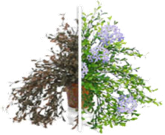By Joan Allen – Assistant Extension Educator – UConn Home & Garden Center
 Plant diseases can have a devastating effect on your garden or landscape, and on your wallet! You may have invested in new cultivars of a favorite plant, only to watch them wilt away. A large tree can add thousands of dollars in value to a property in addition to its beauty or shade, but once lost, can take decades to replace. A vegetable garden may provide food for a family on a tight budget, but disease can ruin the harvest.
Plant diseases can have a devastating effect on your garden or landscape, and on your wallet! You may have invested in new cultivars of a favorite plant, only to watch them wilt away. A large tree can add thousands of dollars in value to a property in addition to its beauty or shade, but once lost, can take decades to replace. A vegetable garden may provide food for a family on a tight budget, but disease can ruin the harvest.
Tips For Managing Plant Disease
From choosing the right plants to cleaning up garden debris, disease prevention using an integrated approach is the key to sustainably managing plant disease. These management practices can protect the time and money you’ve invested in your home garden or landscaping.
- Choose plants suitable for the site
Plants well-adapted to their location will grow better and resist disease and insect problems more effectively. Make sure to match the plant’s growing conditions to the location you want to put them. Consider sun vs. shade, soil characteristics, wind exposure, proximity to road salt applications, and the plants hardiness zone. - Choose disease-resistant plant varieties and seeds
Many plants are available in varieties with resistance to common diseases. Check catalog descriptions or plant labels for this information. If you’ve had trouble with a disease this season, resistant varieties are a good way to avoid it next year. Purchase disease-free seed or transplants: When buying seeds, look for certified disease-free seed. When growing your own transplants, use disinfected or new supplies. Only buy healthy-looking transplants. - Use appropriate fertilization and irrigation
Fertilize and water as needed during the growing season .Healthy, vigorously growing plants are more resistant to disease. Prepare the soil by using the results of a soil test as a guide. How you water your plants can have an important role in reducing disease. Water at the base of the plants and avoid watering the leaves to keep them dry. If overhead irrigation is used, water early in the morning. - Sanitation
Sanitation is an important part of chemical-free disease management. Sanitation includes good weed control, removal of diseased plants or parts, and cleanup of debris at the season’s end. Weeds can be susceptible to some of the same diseases as your garden plants so they can be a source of infection. Weeds provide shelter and food for insects andplant pathogens. They limit airflow, increase moisture and compete for nutrients. Control weeds by pulling them or use cover crops or mulch. Plant debris should be cleaned up thoroughly at the end of the season. Some pathogens survive the winter in dead plant material, releasing spores the following year. Diseased plants should not be put in your compost pile. Plant debris can be tilled into the ground where it will decompose more rapidly than if left on the surface. - Crop rotation
Crop rotation is helpful for some plant diseases that are able to survive in the soil without their host for four years or less. Rotate crops from different plant groups, for example, replace tomatoes with cucumbers or beans the following year. - Vector control
In some cases, plant pathogens are spread by vectors. The most common vectors are insects. Controlling the vector by reducing weeds, using floating row cover, or with insect repellants or insecticidal products is effective in the control of some of these diseases. - Monitoring
Check the garden regularly for signs of disease such as leaf spots, wilt, cankers, stunting or distortion. Catching a disease early and removing affected parts may be effective. Remove plants with severe or advanced symptoms. - Chemical control
Many products are available to help combat disease in the garden. Sustainable options* include a variety of active ingredients: biologicals (fungi or bacteria), copper products, botanical oils, mineral oil, bicarbonates, sulfur, and hydrogen dioxide. Some ‘home remedy’ materials are often tried or recommended but most have not been rigorously tested for effectiveness and include materials such as baking soda, milk, and compost tea.
In combination, these tools will have a major impact in reducing disease in your garden. Sometimes, in spite of using multiple practices to prevent plant disease, losses occur. When weather is favorable for disease, prevention can be challenging.